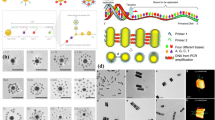Abstract
Plasmonic circular dichroism (CD) responses of hybrid nanostructures containing noble metal nanoparticles and chiral molecules have received increasing interest with various applications in nanophotonics. Chiral biomolecules show strong CD signals typically found in the ultraviolet region, whereas, in the visible range, they produce a weak signal. Strengthening the CD signal in the visible region is of high importance, which could be achieved through fabrication of novel hybrid nanostructures. Herein, gold nanoparticles (GNPs) have been assembled via DNA linker to investigate the possibility of enhancing plasmonic CD signal in the visible range. DNA-linked assemblies with pre- and postannealed conditions were characterized by ultraviolet–visible spectroscopy, dynamic light scattering (DLS), and CD spectropolarimetry. In the presence of DNA linker with sticky ends, the aggregation phenomenon was traced by red shifts of surface plasmon resonance of nanoparticles. Time-dependent hybridization of single-stranded “sticky ends” with DNA-conjugated GNPs and increased probability of hydrogen bond formation lead to enhancement of CD signals in the ultraviolet region. Complexation of biomolecule and nanoparticle assemblies induced enhanced CD signals in the visible range, which was noticed both before and after purification. DLS characterization of the assemblies also confirmed the difference in the size of aggregates, which could be controlled by the linker molecules. This investigation encourages possibility of utilizing plasmonic CD technique as a tool for tracing fabricated nanostructure assemblies with enhanced characterization possibility.






Similar content being viewed by others
References
Haes AJ, Haynes CL, Mcfarland AD et al (2005) Plasmonic materials for surface-enhanced sensing and spectroscopy. MRS Bull 30:368–375
Azizi A, Ranjbar B, Khajeh K et al (2011) Effects of trehalose and sorbitol on the activity and structure of Pseudomonas cepacia lipase: spectroscopic insight. Int J Biol Macromol 49:652–656
Murray W, Barnes W (2007) Plasmonic materials. Adv Math 19:3771–3782
Li H, Carter JD, LaBean TH (2009) Nanofabrication by DNA self-assembly. Mater Today 12:24–32
Kuzyk A, Schreiber R, Fan Z et al (2012) DNA-based self-assembly of chiral plasmonic nanostructures with tailored optical response. Nature 483:311–314
Yang D, Campolongo MJ, Nhi Tran TN et al (2010) Novel DNA materials and their applications. Nanomed-Nanotechnol 2:648–669
Mirkin CA, Letsinger RL, Mucic RC et al (1996) A DNA-based method for rationally assembling into macroscopic materials. Lett Nature 382:607–609
Tan SJ, Campolongo MJ, Luo D et al (2011) Building plasmonic nanostructures with DNA. Nature Nanotechnol 6:268–276
Park SY, Gibbs-Davis JM, Nguyen ST et al (2007) Sharp melting in DNA-linked nanostructure systems: thermodynamic models of DNA-linked polymers. J Phys Chem B 111:8785–8791
Storhoff JJ, LazaridesAa MRC et al (2000) What controls the optical properties of DNA-linked gold nanoparticle assemblies? J Am Chem Soc 122:4640–4650
Jin R, Wu G, Li Z et al (2003) What controls the melting properties of DNA-linked gold nanoparticle assemblies? J Am Chem Soc 125:1643–1654
Ranjbar B, Gill P (2009) Circular dichroism techniques: biomolecular and nanostructural analyses—a review. Chem Biol Drug Des 74:101–120
Fan Z, Govorov AO (2010) Plasmonic circular dichroism of chiral metal nanoparticle assemblies. Nano Lett 10:2580–2587
Li Z, Zhu Z, Liu W et al (2012) Reversible plasmonic circular dichroism of Au nanorod and DNA assemblies. J Am Chem Soc 134:3322–3325
George J, Thomas KG (2010) Surface plasmon coupled circular dichroism of Au nanoparticles on peptide nanotubes. J Am Chem Soc 132:2502–2503
Gérard VA, Gun’ko YK, Defrancq E et al (2011) Plasmon-induced CD response of oligonucleotide-conjugated metal nanoparticles. Chem Comm 47:7383–7385
Anker JN, Hall WP, Lyandres O et al (2008) Biosensing plasmonic nanosensors. Nat Math 7:442–453
Acknowledgments
The authors would like to thank the research council of Tarbiat Modares University for financial support of this work and Mrs. Negar Nadafy for her significant contributions.
Author information
Authors and Affiliations
Corresponding author
Rights and permissions
About this article
Cite this article
Azizi, A., Ranjbar, B., Moghadam, T.T. et al. Plasmonic Circular Dichroism Study of DNA–Gold Nanoparticles Bioconjugates. Plasmonics 9, 273–281 (2014). https://doi.org/10.1007/s11468-013-9620-0
Received:
Accepted:
Published:
Issue Date:
DOI: https://doi.org/10.1007/s11468-013-9620-0




